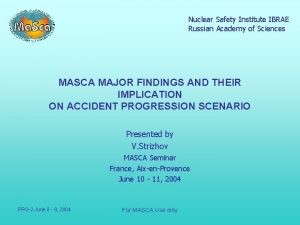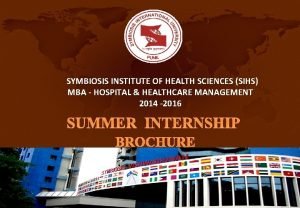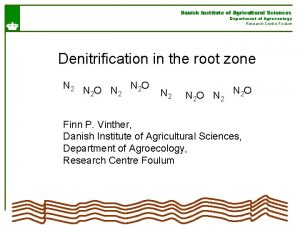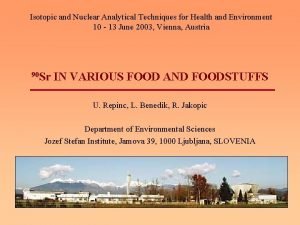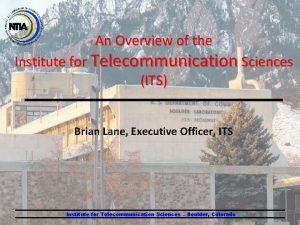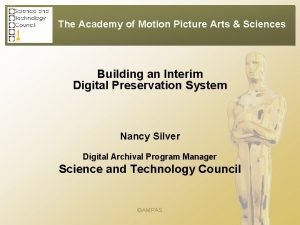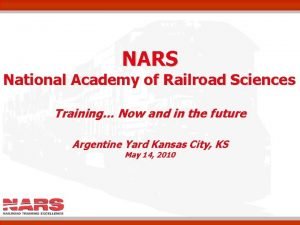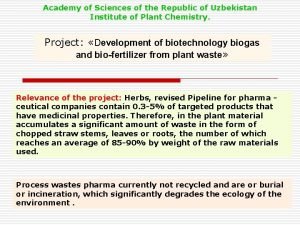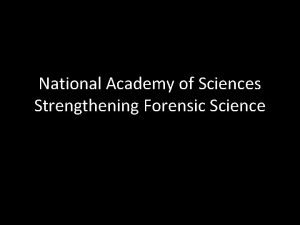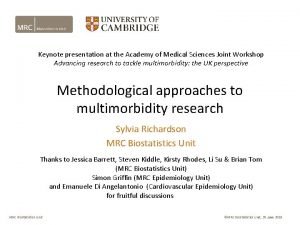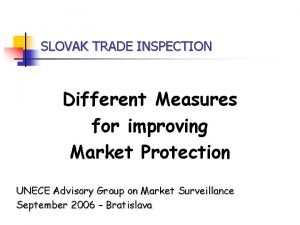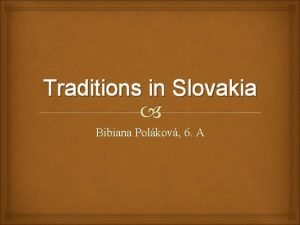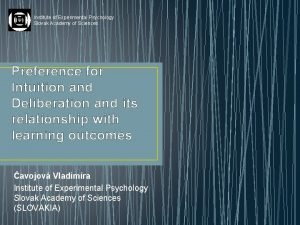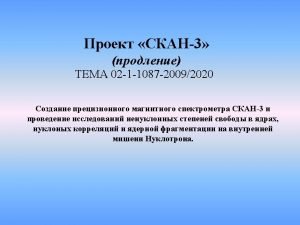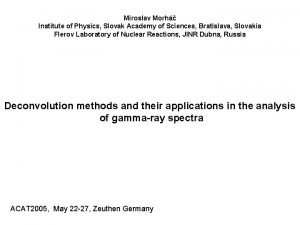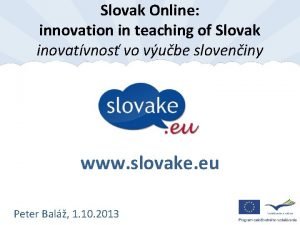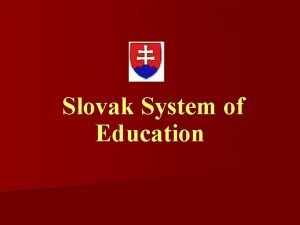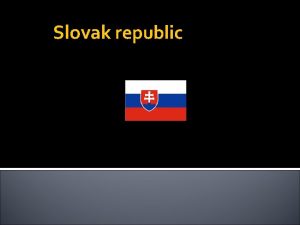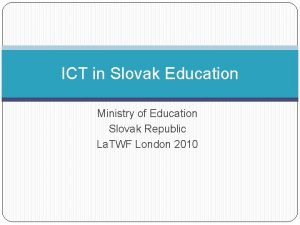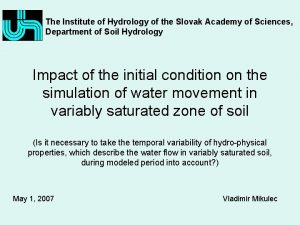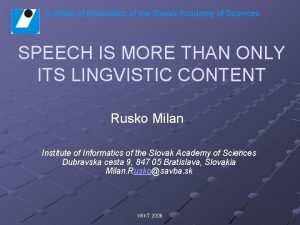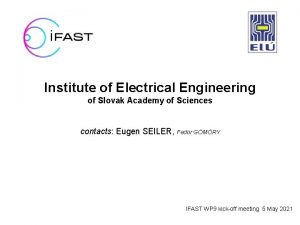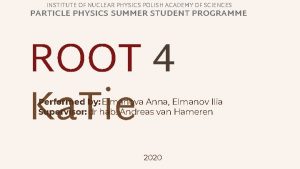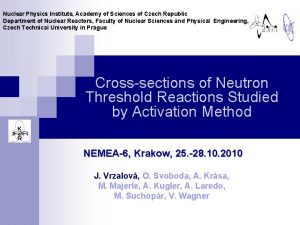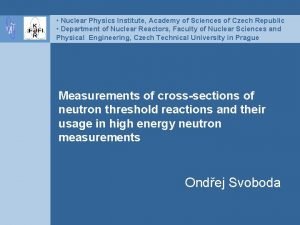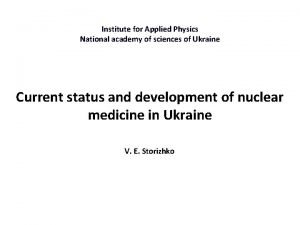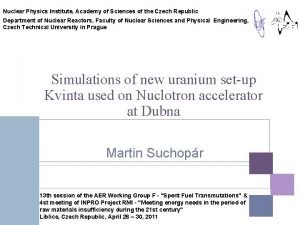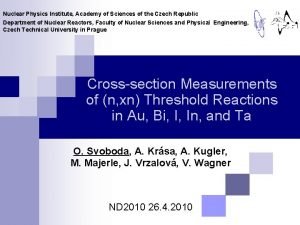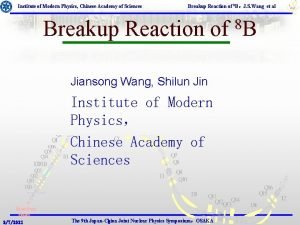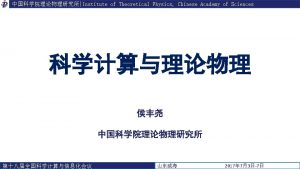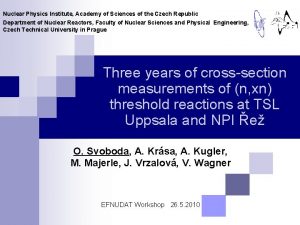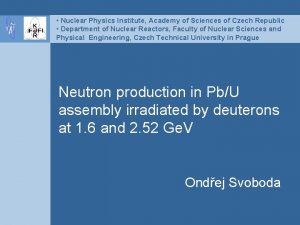Institute of Experimental Physics Slovak Academy of Sciences





![Parameters affecting on SBSL relative intensity of light emitted radius [μm] SBSL no SBSL Parameters affecting on SBSL relative intensity of light emitted radius [μm] SBSL no SBSL](https://slidetodoc.com/presentation_image_h2/90fa6e97ebafa832cf0180c0dc6f1ca3/image-6.jpg)


![Temperature estimation: SBSL Spectrum spectral flow [W. nm-1] 10 -8 10 -9 • • Temperature estimation: SBSL Spectrum spectral flow [W. nm-1] 10 -8 10 -9 • •](https://slidetodoc.com/presentation_image_h2/90fa6e97ebafa832cf0180c0dc6f1ca3/image-9.jpg)















- Slides: 24

Institute of Experimental Physics Slovak Academy of Sciences, Kosice Doctoral Seminar IEP SAS 2009 Ivan Hamráček June 24. 2009

Zadanie doktorandskej záverečnej práce fakulta: Prírodovedecká fakulta UPJŠ stredisko: Ústav fyzikálnych vied študijný odbor: Fyzika kondenzovaných látok a akustika školiace stredisko: Ústav experimentálnej fyziky, SAV názov práce: Štúdium sonoluminescencie cieľ: 1. rok (2008 -2009) • vybudovanie aparatúry pre štúdium sonoluminiscencie (SL), jej optimalizácia a automatizácia • príprava spektrometrických meraní • meranie spektier sonoluminiscencie pri rôznych podmienkach a kvapalinách • reprodukovateľnost výsledkov s rôznymi rezonátormi • porovnanie výsledkov s existujúcimi dátami • testovanie silikónového detektora a jeho časových charakteristík 2. rok (2009 -2010) • vybudovanie a testovanie aparatúry pre meranie časových charakteristík SL • Mie rozptyl na bubline 3. -4. rok (2010 -2012) • publikačná činnosť školiteľ: RNDr. Jaroslav Antoš, CSc. dátum zadania: 01. 10. 2008 dátum odovzdania: 30. 09. 2012 June 24. 2009 Ivan Hamracek, Doctoral Seminar IEP SAS 2009 2

Sonoluminescence (SL) light emitting from the gaseous bubbles in the liquid excited by the acoustic pressure field temperature in bubble (~ 10. 000 K ) light flash duration (~100 ps) SBSL in water; I. Hamracek; April 2006 MBSL June 24. 2009 Ivan Hamracek, Doctoral Seminar IEP SAS 2009 3

Single Bubble Sonoluminescence (SBSL) one gaseous bubble trapped in the center of the flask exposed to ultrasound June 24. 2009 Ivan Hamracek, Doctoral Seminar IEP SAS 2009 4

SBSL Cycle bubble expansion and implosion • volume shift by factor 106 • slow isothermal expansion • fast adiabatic colaps t ~ 60 - 250 ps 50 1 40 § shock wave • high pressure and temperature § radius [μm] 30 0 20 v. R ~ 4 M 10 flash • periodic intervals • 106 photons -1 0 0 10 R 0 ~ 5 m June 24. 2009 acoustic amplitude [ATM] § RMAX ~ 50 m Ivan Hamracek, Doctoral Seminar IEP SAS 2009 20 30 time [μs] R 0 ~ 0, 5 m T ~ 104 - 108 K! 7
![Parameters affecting on SBSL relative intensity of light emitted radius μm SBSL no SBSL Parameters affecting on SBSL relative intensity of light emitted radius [μm] SBSL no SBSL](https://slidetodoc.com/presentation_image_h2/90fa6e97ebafa832cf0180c0dc6f1ca3/image-6.jpg)
Parameters affecting on SBSL relative intensity of light emitted radius [μm] SBSL no SBSL 50 40 30 20 10 0 Weninger et al. ; May 1995 1, 3 10 20 time [μs] 30 40 50 1, 2 acoustic 1, 1 amplitude [ATM] Hiller et al. ; 1992 • • • liquid used bubble gas used acoustic amplitude ambient temperature others? SL intensity S. Putterman; February 1995 1 0, 1 10 % inert gas in N 2 100 M. P. Brenner; April 2002 June 24. 2009 Ivan Hamracek, Doctoral Seminar IEP SAS 2009 9

Aims and Motivation § motivation § § SBSL light production mechanism still unknown bubble temperatures 104 K ( 108 K ? ) (possible exploitation of SBSL for initiation of nuclear fusion) simple apparatus required (for SBSL initiation) aims § § June 24. 2009 stable condition preparation for SBSL observation estimate temperature inside bubble by means of spectrum of SBSL light emitted at different experiment conditions estimation of flash duration (~100 ps) scaling of bubble temperature Ivan Hamracek, Doctoral Seminar IEP SAS 2009 10

Stable condition preparation § § June 24. 2009 experimental apparatus for SBSL creation technology of proper conditions for stable SBSL cylindrical resonator automation of SBSL creation Ivan Hamracek, Doctoral Seminar IEP SAS 2009 16
![Temperature estimation SBSL Spectrum spectral flow W nm1 10 8 10 9 Temperature estimation: SBSL Spectrum spectral flow [W. nm-1] 10 -8 10 -9 • •](https://slidetodoc.com/presentation_image_h2/90fa6e97ebafa832cf0180c0dc6f1ca3/image-9.jpg)
Temperature estimation: SBSL Spectrum spectral flow [W. nm-1] 10 -8 10 -9 • • • continuous in 190 nm – 700 nm region UV sector absorbed by water light production mechanism still unknown • • • Planck distribution fit peak location total energy 10 -10 10 -11 10 -12 200 300 400 500 600 700 wavelength [nm] 800 SBSL in 85% H 2 SO 4; D. J. Flannigan, K. S. Suslick; March 2005 June 24. 2009 Ivan Hamracek, Doctoral Seminar IEP SAS 2009 17

Temperature estimation: SBSL Spectrum • • • wavelength calibration absolute spectral response calibration verification medium absorbance analysis suitable optical apparatus • Ocean. Optics USB 4000 Spectrometer • detector range 200 – 900 nm (3648 pixels) • integration time 3. 8 ms – 10 s Uncalibrated deformed SBSL Spectrum 200 -900 nm, 7 s/20 average/10 box, Hamráček, 2007 June 24. 2009 Ivan Hamracek, Doctoral Seminar IEP SAS 2009 18

SBSL Spectrum Wavelength Calibration • • • wavelength drift slightly (time and environmental conditions) Ocean. Optics HG-1 Mercury Argon Calibration Source • low-pressure gas discharge lines of mercury and argon • 253 -922 nm • 25 lines spectrum calibration included with every measurement automatization needed study of external effects on w. c. (spec. board temperature, integration time, averaging, source runtime) June 24. 2009 Ivan Hamracek, Doctoral Seminar IEP SAS 2009 19

SBSL Spectrum Wavelength Calibration • • automatized calibration in Lab. View environment HG-1 spectrum and spectrum parameters loaded saturated and wrong lines recognition and exclusion true tabulated lines identificated λP = λ 0 + C 1 P + C 2 P 2 + C 3 P 3 (λ as polynomial function of pixel) automated decision of calibration necessity (σ and ΔMAX limits) data saved into text file for calibration history June 24. 2009 Ivan Hamracek, Doctoral Seminar IEP SAS 2009 20

SBSL Spectrum Absolute Spectral Response Calibration • • • LS-1 -CAL Calibration Light Source spectral range: 300 – 1050 nm lamp file DT-MINI-2 -GS Deuterium Tungsten Halogen Light Source 200 -410 nm D, 360 -2000 nm TH June 24. 2009 Ivan Hamracek, Doctoral Seminar IEP SAS 2009 21

SBSL Spectrum Calibration Verification • spectrum of well-known thermal sources • Tungsten filament, Sun, Mon, candle. . . • Tungsten filament temperature estimation • Stefan – Boltzman law • A – radiation emitting area • filament diameter estimation • P – radiation power (P=U. I) • ε – emittance (gray body, ε(λ, T)), σ – Stefan Boltzmann constant June 24. 2009 Ivan Hamracek, Doctoral Seminar IEP SAS 2009 22

SBSL Spectrum Calibration Verification • tabulated resistance-temperature fit γ = 0, 82373 ± 0, 00003 • • infrared thermometer automated Tungsten filament temperature estimator (Lab. View) • (current & voltage controling and recording, power, temperatures & uncertainities calculating, data saving) June 24. 2009 Ivan Hamracek, Doctoral Seminar IEP SAS 2009 23

SBSL Spectrum Calibration Verification • absolute temperature • Planck distribution fit (shape) • peak location (sufficient range) • total energy (sufficient range) • relative temperature June 24. 2009 Ivan Hamracek, Doctoral Seminar IEP SAS 2009 24

Light Flash Duration Photon Counting • low-light-level measurements (luminescence, fluorescence) • incident photons are detected as separate pulses • average time intervals between signal pulses are wider than the time resolution of PMT • signal stability, detection effeciency, signal-to-noise ratio • <100 ps time resolution • 2 fast detectors - time difference of signal registration distribution Light source PMT CFD start PMT CFD stop TAC U(Δt) MCA PMT – MPPC, CFD – constant fraction discriminator , TAC – time to amplitude converter, MCA – multichannel analyzer June 24. 2009 Ivan Hamracek, Doctoral Seminar IEP SAS 2009 25

Light Flash Duration Silicon Photomultiplier (Si. PM) • • • novel type semiconducting photon senzor built from an avalanche photodiode (APD) array on common Si substrate sensitive size 1 x 1 mm 2 great photon dtection ability excellent cost performance very compact size SPMMini PMT June 24. 2009 Ivan Hamracek, Doctoral Seminar IEP SAS 2009 26

Light Flash Duration Averaged signal D 1 FEU D 2 D 4 June 24. 2009 Ivan Hamracek, Doctoral Seminar IEP SAS 2009 FEU 28

Light Flash Duration Signal persistence D 1 FEU June 24. 2009 D 2 FEU Ivan Hamracek, Doctoral Seminar IEP SAS 2009 D 4 FEU 30

Light Flash Duration Photon resolution June 24. 2009 Ivan Hamracek, Doctoral Seminar IEP SAS 2009 D 4 32

Conclusion § conditions for stable SBSLobservations § experimental apparatus for SBSL creation – done § technology of proper conditions for stable SBSL (even hours) - done § cylindrical resonator § SBSL temperature estimation § raw SL spectra - done § automated wavelength calibration - done § absolute spectral response calibration – done § automated tungsten filament temperature estimation – almost done § sun, moon temperature § medium absorbance analysis § suitable optical apparatus construction § uncertainities estimation § possibility of temperature regulations June 24. 2009 Ivan Hamracek, Doctoral Seminar IEP SAS 2009 33

Conclusion § estimation of flash duration § confirmation of one light flash per one acoustic cycle – done § confirmation of flash duration being of couple orders lower than acoustic cycle (PMT) – done § flash registration with MPPC (3 bare detectors from Dolgoshein, one comercial with preamplifier and Peltier cooling) – in progress § uncertainities estimation § diameter measurements § corelations between parameters (pressure amplitude, temperature, intensity, flash duration) June 24. 2009 Ivan Hamracek, Doctoral Seminar IEP SAS 2009 34

Thank you for your attention! June 24. 2009 Ivan Hamracek, Doctoral Seminar IEP SAS 2009 35
 Nuclear safety institute of the russian academy of sciences
Nuclear safety institute of the russian academy of sciences The human sciences tok
The human sciences tok Experimental vs non experimental
Experimental vs non experimental Experimental research design types
Experimental research design types Disadvantages of experimental research
Disadvantages of experimental research Non experimental design vs experimental
Non experimental design vs experimental Nonexperimental study
Nonexperimental study Symbiosis hospital management
Symbiosis hospital management Danish institute of agricultural sciences
Danish institute of agricultural sciences Health and environmental sciences institute
Health and environmental sciences institute Institute for telecommunication sciences
Institute for telecommunication sciences Kafue institute of health sciences
Kafue institute of health sciences Kafue institute of health sciences
Kafue institute of health sciences Hazleton area academy of sciences
Hazleton area academy of sciences Academy of motion picture arts and sciences benefits
Academy of motion picture arts and sciences benefits Railroad training school
Railroad training school Hawaii academy of arts and science
Hawaii academy of arts and science Putnam academy of arts and sciences
Putnam academy of arts and sciences Uzbek academy of sciences
Uzbek academy of sciences National academy of sciences forensic science
National academy of sciences forensic science Comorbidity examples
Comorbidity examples Cleveland arts and social sciences academy
Cleveland arts and social sciences academy Slovak trade inspection
Slovak trade inspection Slovak easter traditions
Slovak easter traditions Slovak wedding traditions
Slovak wedding traditions
